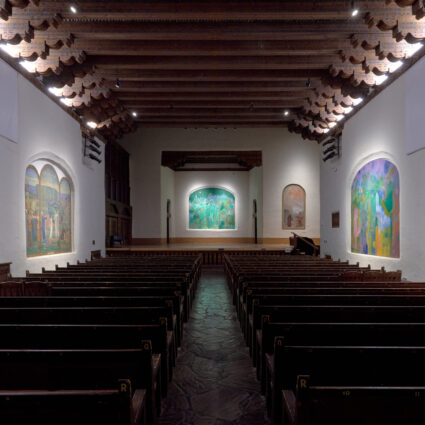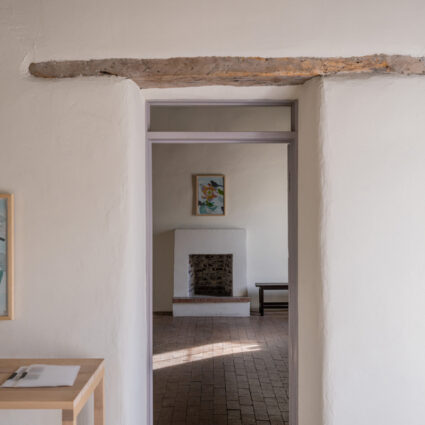David Richard Gallery, Santa Fe
September 6-24, 2016
Let us sing the praises of art galleries who dare set up shop in risky neighborhoods—neighborhoods that are neither Downtown, on Canyon Road, nor in the Railyard Arts District. David Richard Gallery made the move toward lowering their rent by relocating, at the beginning of 2016, to Mid-Town, or the Pacheco Corridor, or St. Michael’s Triangle, or whatever you want to call it (Mid-Mike’s? PaTriCo? NoRad, for No Longer in the Railyard? Downton Warehouse?). Since then, co-owners David Eichholtz and Richard Barger have been able to, according to their website, “bring New Mexico’s homegrown, truly contemporary work into focus on a larger scale . . . featuring some of Santa Fe’s best and brightest.” Why? Because now these gallerists can afford to, for one; and two, because they see what this town needs, has always needed, and will hopefully continue to need: cheap places for artists to live and work, and to show their stuff. Most importantly, David and Richard know how to read “buzz,” and right now said buzz is being generated from a hive of creatives in the not-so-historic districts of Santa Fe. If it’s not loaded with tourists, it just might be close to affordable—although the meaning of “affordable” in this town is quite laughable.
The name of the program bringing work by these best and brightest under the gallery lights at David Richard is, aptly, The Santa Fe Art Project, and it consists of three rounds of paired exhibitions, curated by four teams. The project took off in early September and runs for eight weeks; at press time two rotations had taken place. Each of the three parts includes an exhibition curated by Eichholtz, with input from such sidekicks and collaborators as New York’s Howard Rutkowski and Peter Frank of Los Angeles, alongside a guest-curated exhibition. While I am always a fan of Eichholtz’s fabulous eye when it comes to choosing, installing, and lighting work in his galleries, I’ve been drawn to the guest curators’ visions, if only because of how they each have revealed something uniquely suited to a place in the David Richard galleries—wholly viable on a commercial and an experimental basis. Basins (September 9-24) was curated by John McKissick of alternative art space Radical Abacus. Santa Fe Collective partners Jennifer Joseph and Chris Collins curated the five-woman show Women’s Work (September 30-October 15). The final guest-curated exhibition is titled Outer Local (October 21-November 6), and puts SCUBA collective artists Crockett Bodelson and Sandra Wang at the curating helm.
The amazing thing, for a town of Santa Fe’s population and demographics, is that these discussions are usually well-attended, and often the audience members’ average age is under 50.
The Project is accompanied by almost weekly artist talks and panel discussions, public dialogue being an ongoing strong point at David Richard. (Full disclosure: This writer has moderated a few discussions at DRG.) The amazing thing, for a town of Santa Fe’s population and demographics, is that these discussions are usually well-attended, and often the audience members’ average age is under 50.

An exhibition that represents the all-round fine quality of The Santa Fe Art Project, regardless of which curators we’re considering, was Women’s Work. It featured the artists and aesthetics of Jennifer Joseph and Chris Collins’s former Santa Fe Collective, which they closed recently when other opportunities came up. A common theme in Women’s Work was surface, especially as investigated by painters Joseph, Sydney Cooper, and Terri Rolland. Thais Mather and Lucrecia Troncoso showed drawings and mixed-media installations. All too infrequently a presence in this community, it was refreshing to see Troncoso’s postminimalist works in a show again. Her references to Eva Hesse are unmistakable, yet the work is far from derivative. It is intelligent without ever feeling show-offy. Mather’s pen-and-ink pointillist drawings are edgy and somehow unresolved, strangely satisfying in their tension between content and concept. A delightful surprise by this artist lurked in a quiet hallway; Rolling, which consisted of, from left to right in a small vitrine hung on the wall, a diamond, a prehistoric spinning wheel, and six hits of LSD. The play of these objects on the exhibition title, Women’s Work, is just as drolly thoughtful as the artist herself. Finally, while it wasn’t discussed at the panel featuring the artists, a subtext of the show might well be overt beauty for beauty’s sake. That was my takeaway, as is usual when I leave an exhibition at David Richard Gallery, as in “Boy, that was beautiful.”



